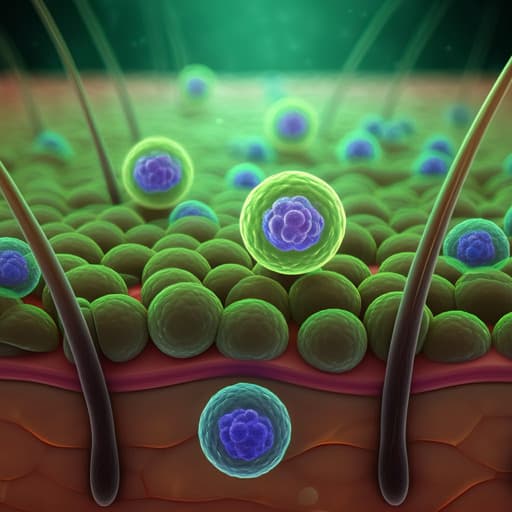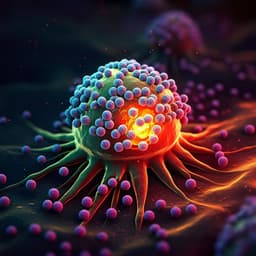
Medicine and Health
Advances in Photodynamic Therapy for the Treatment of Actinic Keratosis and Nonmelanoma Skin Cancer: A Narrative Review
A. S. Farberg, W. Justin, et al.
Discover the latest advancements in photodynamic therapy (PDT) for treating actinic keratoses and nonmelanoma skin cancers. This narrative review explores innovative PDT protocols and methods to enhance efficacy while minimizing discomfort, authored by experts Aaron S Farberg, W Justin, Teo Marson, Soleymani, and T. Soleymani.
~3 min • Beginner • English
Introduction
Nonmelanoma skin cancers (NMSC), predominantly basal cell carcinoma (BCC) and cutaneous squamous cell carcinoma (cSCC), arise from epidermal keratinocytes and are linked to risk factors such as age, lighter skin phototype, occupational and environmental ultraviolet (UV) exposure, and cumulative sun damage. Actinic keratoses (AKs) represent precancerous lesions with variable malignant potential and contribute to field cancerization, where clinically normal skin harbors genetic alterations. Patients with AKs have a higher incidence of cSCC than matched controls, especially younger patients. Early detection and treatment of AKs and cancerized fields are therefore critical. PDT is a nonsurgical option using topical precursors of protoporphyrin IX (PpIX) activated by visible light to produce reactive oxygen species that destroy atypical keratinocytes. Common photosensitizers include ALA, MAL, and BF-200 ALA. In the USA, 20% ALA with blue light is approved for minimally to moderately thick AKs, and BF-200 ALA with red light is approved for lesion- and field-directed treatment of mild-to-moderate AKs of face/scalp. In Europe, MAL and BF-200 ALA with red light are approved for AK, cSCC in situ, and superficial/nodular BCC, with limitations for lesion thickness and aggressive histologic subtypes. This review synthesizes recent and ongoing research on PDT for AKs, field cancerization, and off-label use in NMSC, with emphasis on efficacy, tolerability, and protocol innovations.
Literature Review
This is a narrative review based on previously published studies. PubMed was searched from inception to February 2022 using [(aminolevulinic acid OR aminolevulinate) AND photodynamic therapy] in combination with (broad area OR field-directed), (squamous cell carcinoma OR basal cell carcinoma), and (efficacy OR pain OR tolerability). Key recent and relevant publications were summarized regarding advances in clinical application (field cancerization, BCC, cSCC), protocol innovations (alternative light sources, pretreatments, thermal PDT, combination therapy, reduced incubation, daylight PDT), and data in organ transplant recipients. No new human or animal studies were conducted by the authors.
Methodology
Narrative review using a PubMed search of the medical literature from database inception through February 2022. Search terms included: (aminolevulinic acid OR aminolevulinate) AND photodynamic therapy, combined with (broad area OR field-directed), (squamous cell carcinoma OR basal cell carcinoma), and (efficacy OR pain OR tolerability). Studies selected as most relevant and recent were synthesized. The article contains no new clinical experiments; it summarizes interventional trials, split-face studies, case series, and case reports on PDT in AKs, field cancerization, BCC, and cSCC, and reviews innovations (light sources, pretreatments, heating, combination regimens, shortened incubation, and daylight PDT), including specific data in organ transplant recipients.
Key Findings
- Field cancerization: In a 52-week RCT of high-risk patients, three sessions of broad-area ALA-PDT (20% ALA, 1-h incubation, blue light) reduced AK counts vs vehicle (least squares mean 2.1 vs 4.7; P=0.0166), increased probability of no AKs (37.5% vs 18.9%; P=0.0089), prolonged response, and reduced new NMSCs (5/56 vs 12/53; P=0.0014) with no major differences between two vs three sessions. A phase 3 RCT of field-directed BF-200 ALA with red light achieved 91% complete clearance vs 22% with vehicle at 12 weeks (P<0.0001).
- BCC (off-label): After pretreatment curettage (debulking), MAL-PDT (16% MAL, red LED) yielded 3-year clearance rates of 96.1% (superficial BCC; mean 2.6 sessions) and 95.2% (nodular BCC; mean 2.7 sessions). 5-ALA gel with 3-h incubation and red light achieved 95.8% complete response at 3 months and 88.3% 3-year recurrence-free survival. Another series using 20% 5-ALA, 4-h incubation, red light saw 87% single-session complete response (47/54), increasing with a second session. In Gorlin syndrome, blue light was noninferior to red light for BCC clearance (98% vs 93%; noninferiority P<0.001; 5% margin), with anecdotal lower pain for blue light.
- Alternative light sources: IPL- and PDL-activated PDT showed AK clearance of ~68–90% at 3 months in small studies with 20% ALA or MAL. In a split-face trial, PDL-PDT had similar AK efficacy to conventional LED-PDT at 12 months but significantly lower pain (VAS mean difference -4.55; P<0.01). In a 220-patient study, IPL+blue LED achieved 84.4% AK reduction at 1 month vs PDL 70.5%, PDL+blue LED 69.3%, IPL 70.8%.
- Pretreatments to enhance uptake: Microneedling results are mixed; some split-face studies showed no difference, others showed significant AK reduction (e.g., 76–89.3% vs 58–69.5% at 1–4 months). AFR (CO2 or Er:YAG) prior to PDT increased efficacy: e.g., CO2 AFR + ALA-PDT yielded 70.6% complete response after three sessions with shortened MAL incubation; another study reported 91.3% lesion reduction 3 months after single CO2 AFR + ALA-PDT with artificial daylight. In OTRs, AFR-DL-PDT produced higher complete response (74%) vs DL-PDT without AFR (46%; P=0.026) and vs conventional PDT (50%; P=0.042). A split-side trial showed AFR-DL-PDT superior to microdermabrasion pretreatment for AK clearance and fewer new AKs.
- TMFI pretreatment increased PpIX fluorescence and 5-ALA penetration vs controls (P<0.001) in healthy skin, with mild reactions; clinical efficacy in AK/NMSC remains untested.
- Thermal PDT: Heating during incubation improved clearance. A split-side extremity AK study (20% ALA, 1 h) showed higher clearance with heated incubation (median 88.0% vs 70.5% at 2 months; 88.0% vs 67.5% at 6 months; both P<0.0001) but more erythema/stinging/crusting. A facial AK pilot (20% ALA, ~20-min incubation at 38–42°C) achieved ~91.5% lesion clearance at 2 months with moderate pain during illumination.
- Combination therapy: Short-course pretreatment enhanced PDT efficacy. 5-FU BID for 1 week before MAL DL-PDT improved mean lesion response at 3 months (62.7% vs 51.8%; P=0.0011) without added PDT pain. Calcipotriol pretreatment before MAL DL-PDT increased complete remission (85% vs 70%) with more erythema.
- Shortened incubation and immediate illumination: ALA-PDT efficacy is preserved with shorter incubations, with less pain. Broad-area ALA-PDT with 1-h vs 3-h incubation had comparable 12/24-week complete clearance but lower stinging/burning and erythema with 1 h (e.g., immediate post-PDT stinging/burning 63.8% vs 78.7%). Split-face studies with immediate illumination (no incubation) showed similar 3-month efficacy and markedly reduced pain; case report corroborated near-painless, near-clearance at 4 months.
- Daylight PDT (DL-PDT): Meta-analysis of 6 RCTs found DL-PDT noninferior to conventional red light PDT for Grade I–II AKs (RR 0.97; 95% CI 0.91–1.04) with significantly less pain (mean difference -4.51; P<0.001), but less effective for Grade III AKs (RR 0.87; 95% CI 0.81–0.94). Split-side trials showed DL-PDT efficacy with BF-200 ALA vs MAL (12-week clearance ~80% vs ~77%; BF-200 ALA had lower 1-year recurrence 19.9% vs 31.6%, P=0.01). Indoor simulated daylight with BF-200 ALA achieved high clearance (lesions ~85%) with low pain in one small trial; another protocol combining AFR and a multilight lamp had high remission (72%) but severe pain.
- Organ transplant recipients (OTRs): Conventional PDT shows lower complete response vs immunocompetent controls (48-week CR 0.55 [95% CI 0.38–0.71] vs 0.72 [0.54–0.86]). Systematic reviews suggest MAL-PDT complete clearance rates (40–76.4%) exceed imiquimod (27.5–62.1%), diclofenac (41%), and 5-FU (11%), and that PDT may prevent additional AKs/SCCs ≥3 months post-treatment. AFL-assisted MAL-DL-PDT improved responses vs DL-PDT alone (74% vs 46%; P=0.026) and vs conventional PDT (50%; P=0.042). Field therapy may be underutilized in high-risk OTRs.
Discussion
The review supports PDT as an effective, cosmetically favorable modality for AKs, field cancerization, and selected NMSCs (especially superficial and nodular BCCs ≤2 mm thick). Field-directed PDT reduces AK burden and incident NMSC in high-risk patients. Debulking and optimized protocols enhance BCC outcomes. Innovations—alternative light sources (PDL, IPL), pretreatments (AFR, potentially TMFI), thermal modulation, combination with topical agents, reduced incubations, and DL-PDT—can maintain or improve efficacy while reducing pain and improving convenience, which are critical for adherence given the chronic, recurrent nature of photodamage. DL-PDT appears particularly advantageous for Grade I–II AKs due to substantially lower pain. In OTRs, where disease burden and aggressiveness are greater, PDT (especially with AFL assistance or DL-PDT) can treat large fields with low infection risk and may help prevent future lesions, though responses are somewhat attenuated vs immunocompetent patients. Overall, tailoring light sources, incubation times, and pretreatments can address tolerability and efficacy, supporting broader clinical use and informing future protocol optimization.
Conclusion
PDT is being used successfully for individual AKs, field cancerization, and off-label for BCC and cSCC in situ, achieving high clearance rates (often >90% for mild-to-moderate AKs and many BCCs) with favorable cosmetic outcomes. Advances in illumination (e.g., DL-PDT, PDL, IPL), photosensitizer delivery and pretreatments (e.g., AFR, thermal modulation), shorter incubation, and combination regimens show promise to enhance efficacy, reduce pain, and improve convenience. Further well-designed trials are needed to optimize protocols, evaluate durability of clearance, and improve patient experience and adherence, particularly among high-risk populations such as OTRs.
Limitations
As a narrative review, the study selection may be subject to selection bias and heterogeneity across included studies (differences in photosensitizers, incubation times, light sources, pretreatments, outcome definitions, follow-up durations). Many data derive from small trials, split-face designs, or case series; high-quality, large-scale RCTs are limited, particularly for cSCC. DL-PDT efficacy can be impacted by environmental conditions, and tolerability and pain data vary due to nonstandardized protocols. The review includes no new experimental data.
Related Publications
Explore these studies to deepen your understanding of the subject.







